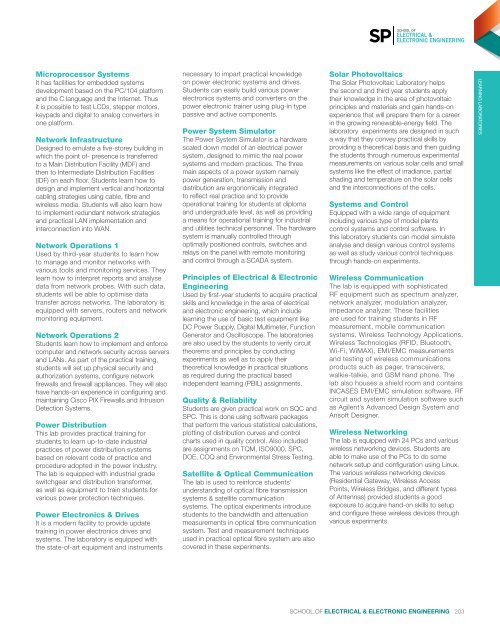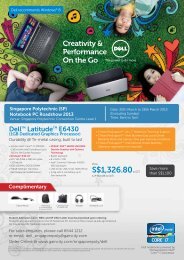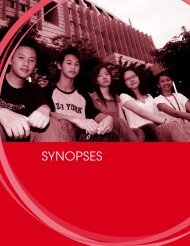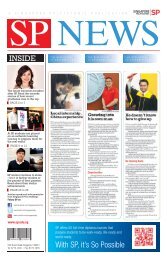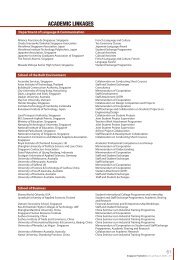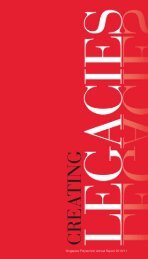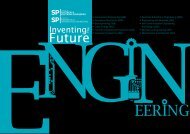Untitled - Singapore Polytechnic
Untitled - Singapore Polytechnic
Untitled - Singapore Polytechnic
- No tags were found...
Create successful ePaper yourself
Turn your PDF publications into a flip-book with our unique Google optimized e-Paper software.
Microprocessor SystemsIt has facilities for embedded systemsdevelopment based on the PC/104 platformand the C language and the Internet. Thusit is possible to test LCDs, stepper motors,keypads and digital to analog converters inone platform.Network InfrastructureDesigned to emulate a five-storey building inwhich the point of- presence is transferredto a Main Distribution Facility (MDF) andthen to Intermediate Distribution Facilities(IDF) on each floor. Students learn how todesign and implement vertical and horizontalcabling strategies using cable, fibre andwireless media. Students will also learn howto implement redundant network strategiesand practical LAN implementation andinterconnection into WAN.Network Operations 1Used by third-year students to learn howto manage and monitor networks withvarious tools and monitoring services. Theylearn how to interpret reports and analysedata from network probes. With such data,students will be able to optimise datatransfer across networks. The laboratory isequipped with servers, routers and networkmonitoring equipment.Network Operations 2Students learn how to implement and enforcecomputer and network security across serversand LANs. As part of the practical training,students will set up physical security andauthorization systems, configure networkfirewalls and firewall appliances. They will alsohave hands-on experience in configuring andmaintaining Cisco PIX Firewalls and IntrusionDetection Systems.Power DistributionThis lab provides practical training forstudents to learn up-to-date industrialpractices of power distribution systemsbased on relevant code of practice andprocedure adopted in the power industry.The lab is equipped with industrial gradeswitchgear and distribution transformer,as well as equipment to train students forvarious power protection techniques.Power Electronics & DrivesIt is a modern facility to provide updatetraining in power electronics drives andsystems. The laboratory is equipped withthe state-of-art equipment and instrumentsnecessary to impart practical knowledgeon power electronic systems and drives.Students can easily build various powerelectronics systems and converters on thepower electronic trainer using plug-in typepassive and active components.Power System SimulatorThe Power System Simulator is a hardwarescaled down model of an electrical powersystem, designed to mimic the real powersystems and modern practices. The threemain aspects of a power system namelypower generation, transmission anddistribution are ergonomically integratedto reflect real practice and to provideoperational training for students at diplomaand undergraduate level, as well as providinga means for operational training for industrialand utilities technical personnel. The hardwaresystem is manually controlled throughoptimally positioned controls, switches andrelays on the panel with remote monitoringand control through a SCADA system.Principles of Electrical & ElectronicEngineeringUsed by first-year students to acquire practicalskills and knowledge in the area of electricaland electronic engineering, which includelearning the use of basic test equipment likeDC Power Supply, Digital Multimeter, FunctionGenerator and Oscilloscope. The laboratoriesare also used by the students to verify circuittheorems and principles by conductingexperiments as well as to apply theirtheoretical knowledge in practical situationsas required during the practical basedindependent learning (PBIL) assignments.Quality & ReliabilityStudents are given practical work on SQC andSPC. This is done using software packagesthat perform the various statistical calculations,plotting of distribution curves and controlcharts used in quality control. Also includedare assignments on TQM, ISO9000, SPC,DOE, COQ and Environmental Stress Testing.Satellite & Optical CommunicationThe lab is used to reinforce students’understanding of optical fibre transmissionsystems & satellite communicationsystems. The optical experiments introducestudents to the bandwidth and attenuationmeasurements in optical fibre communicationsystem. Test and measurement techniquesused in practical optical fibre system are alsocovered in these experiments.Solar PhotovoltaicsThe Solar Photovoltaic Laboratory helpsthe second and third year students applytheir knowledge in the area of photovoltaicprinciples and materials and gain hands-onexperience that will prepare them for a careerin the growing renewable-energy field. Thelaboratory experiments are designed in sucha way that they convey practical skills byproviding a theoretical basis and then guidingthe students through numerous experimentalmeasurements on various solar cells and smallsystems like the effect of irradiance, partialshading and temperature on the solar cellsand the interconnections of the cells.Systems and ControlEquipped with a wide range of equipmentincluding various type of model plantscontrol systems and control software. Inthis laboratory students can model simulateanalyse and design various control systemsas well as study various control techniquesthrough hands-on experiments.Wireless CommunicationThe lab is equipped with sophisticatedRF equipment such as spectrum analyzer,network analyzer, modulation analyzer,impedance analyzer. These facilitiesare used for training students in RFmeasurement, mobile communicationsystems, Wireless Technology Applications,Wireless Technologies (RFID, Bluetooth,Wi-Fi, WiMAX), EMI/EMC measurementsand testing of wireless communicationsproducts such as pager, transceivers,walkie-talkie, and GSM hand phone. Thelab also houses a shield room and containsINCASES EMI/EMC simulation software, RFcircuit and system simulation software suchas Agilent’s Advanced Design System andAnsoft Designer.Wireless NetworkingThe lab is equipped with 24 PCs and variouswireless networking devices. Students areable to make use of the PCs to do somenetwork setup and configuration using Linux.The various wireless networking devices(Residential Gateway, Wireless AccessPoints, Wireless Bridges, and different typesof Antennas) provided students a goodexposure to acquire hand-on skills to setupand configure these wireless devices throughvarious experiments.Learning LABOrATOrIESSCHOOL OF Electrical & Electronic Engineering 203


